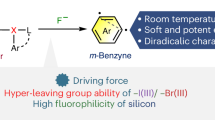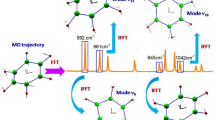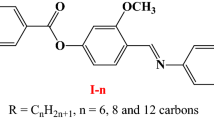Abstract
ALLOWED electronic transitions in aromatic molecules between states approximately described by combinations of pπ atomic orbitals must all be polarized in the molecular plane, and the same is true of the much weaker transitions which take on allowed character only because of the disturbing effect of nuclear vibrations. This is the polarization property actually found in band systems so far studied experimentally, almost all of which have been lowest-energy transitions. Specifically, Scheibe1 showed that the 2800-A. system of hexamethylbenzene is polarized with the active electric vector in the molecular plane. This system certainly corresponds to the well-known 2600 A. system of benzene itself, which is assigned A1g — B2u from vibrational analysis. Hexamethylbenzene crystallizes with all the molecular planes parallel to one another, and perpendicular to the main faces of a sublimed crystal, and so is much better suited to polarization measurements than benzene.
This is a preview of subscription content, access via your institution
Access options
Subscribe to this journal
Receive 51 print issues and online access
$199.00 per year
only $3.90 per issue
Buy this article
- Purchase on SpringerLink
- Instant access to full article PDF
Prices may be subject to local taxes which are calculated during checkout
Similar content being viewed by others
References
Scheibe, G., Hartwig, St., and Muller, R., Z. Electrochem., 49, 372 (1943).
Price, W. C., and Wood, R. W., J. Chem. Phys., 3, 439 (1935).
Hammond, V. J., Price, W. C., Teegan, J. P., and Walsh, A. D., Disc. Farad. Soc., 9, 53 (1950).
Carr, E. P., and Stücklen, H., J. Chem. Phys., 7, 631 (1939).
Goeppert-Mayer, M., and Sklar, A. L., J. Chem. Phys., 6, 645 (1938).
Craig, D. P., J. Chem. Phys., 17, 1358 (1949).
Brockway, L. O., and Robertson, J. M., J. Chem. Soc., 1324 (1939).
Author information
Authors and Affiliations
Rights and permissions
About this article
Cite this article
CRAIG, D., LYONS, L. Polarization of the Second Ultra-violet System in Hexamethylbenzene. Nature 169, 1102 (1952). https://doi.org/10.1038/1691102a0
Issue date:
DOI: https://doi.org/10.1038/1691102a0
This article is cited by
-
Symmetry of the Second Excited Singlet State of Benzene
Nature (1955)



